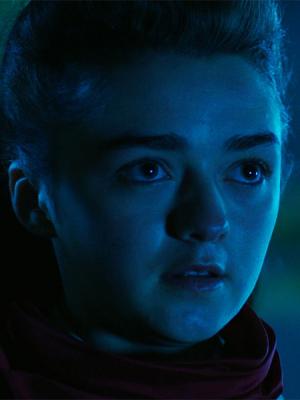 starring Peter Capaldi, Jenna Coleman, Maisie Williams, Rufus Hound, Ariyon Bakare, Struan Rodger, John Voce. Elisabeth Hopper, Gruffudd Glyn, Reuben Johnson
starring Peter Capaldi, Jenna Coleman, Maisie Williams, Rufus Hound, Ariyon Bakare, Struan Rodger, John Voce. Elisabeth Hopper, Gruffudd Glyn, Reuben JohnsonWritten by Catherine Tregenna
Directed by Ed Bazalgette
Transmitted on 24 October 2015
Humanity weighs heavily on the twenty-first century Doctor. The relationship between the Doctor and our species was never taken for granted, but the issues raised by the affiliation of a hundreds-or-thousands-year-old Time Lord to human beings who live a few decades were usually sidestepped except on special self-referential occasions. Now almost all of Doctor Who revels in being self-referential and asks questions about how the Doctor works as a character which weren’t asked very loudly in its twentieth-century version. This year there’s been a greater shift than before to exploring the Doctor’s perspective on events rather than seeing him through the experiences of a companion. The Woman Who Lived finds the Doctor recast as sidekick to someone he thought of as a protegée but with whom – apart from one admittedly rather crucial moment – he has taken no effort.
Caring so someone else doesn’t have to
The plot gives Jenna Coleman an episode off, apart from an epilogue; this episode presents Peter Capaldi’s Doctor for the first time without his midwife, muse and manager. The exercise works: the Doctor can look after himself. In case one still had doubts, the episode sets out to demonstrate that the twelfth Doctor knows how to care, and suggests why he has to. The lasting impression of much of the episode is of a series of two-handed discussions between the Doctor and the sometime Ashildr, who far from being the smiling doer of good works the Doctor has constructed from his glimpse of her in a leper colony (an unsubtle metaphor), Ashildr’s identity is eroded, wounded, and bandaged, a self wrapped up in costume and performativity who only identifies herself, underneath, as ‘Me’. The Doctor has looked in on her from a distance – elevating her to the status of companion given the mention of this practice in The Sarah Jane Adventures: The Death of the Doctor – but he says that this encounter is an accident. Performance and composition ensure that Ashildr’s disappointment when she realises the Doctor hasn’t come to take her away is crushing.
It’s a sign of how far this episode made me feel for the Doctor and hold on to his point of view that I want to continue to call Ashildr by that name rather than as Me. Doctor and audience are looking for points of continuity with the girl we met the previous week. Nevertheless, however alienated she seems, Ashildr is often a character where performance, camera and composition force the audience to consider her as our identification figure. This is a thought experiment in which the audience is made to wonder how they would cope if they became immortal. Given how thoroughly The Girl Who Died established the Viking village as a community, and how rooted Ashildr was within it, it’s a blow to find Ashildr doesn’t remember them, let alone the name she had there. Indeed, here Ashildr has become a pioneer of political economy, a generation before the discipline emerged, talking about the average lifespan with a lack of involvement which presages the revelation of her co-operation with Leandro. She doesn’t appear to be someone who, if a Time Lord, would need to be reminded of her training in detachment, unlike the Doctor.
Nightmare Fair
Before developing the crisis of Ashildr, the episode reels in viewers with a hook which suggests a more swashbuckling episode than one actually gets, but which rapidly builds the period setting as well as undermining its conventions. The ingredients of the seventeenth- or eighteenth-century criminal romance are there, moonlight, horses and mystery. A young woman (whose positioning is misleading - we never see her again, though we hear of her) is threatened in such a way that she seems by her expression to regard it as a possibility of release from imprisonment in social structures by a free spirit. Assumptions about genre are punctured by the disjuncture between Maisie Williams’s diminutive female figure and the deep masculine voice of the Knightmare, and by the glowing eyes of her feline friend in the undergrowth, an enigma parked until later. The Doctor exits from a TARDIS positioned heroically amid trees in a similar environment to the one in which it was left in The Girl Who Died, before undermining the generic situation with actions and prop and comedically defusing the threat of the Knightmare, restoring the social status quo by mistake and undermining both his goal and Ashildr’s.
The episode depicts the struggle for the Doctor to associate Me with the Ashildr he remembers and idealised, while at the same time coming to terms with the consequences of his own actions. It’s not for nothing that he accepts towards the end of the episode that he is a tidal wave in human history. We (and it seems particularly the inhabitants of a particular corner of north-west Europe) are to a great extent his creations, perhaps and more specifically even unwitting players in a tale the Doctor has us act out for his own reassurance. The Doctor is caught in as painful a struggle for self-realisation as the series can manage at this point. The depiction is helped by Maisie Williams’s detached delivery of Ashildr. The marvellous storyteller has gone; her shelves of books aren’t her imaginings but an account of her life which she keeps because otherwise she won’t remember enough to maintain not only knowledge of her experiences but her identity. She defies the conventions of society in speech, denying the statuses of daughter, wife and mother, but she has tried being all these and more. The comedy of Ashildr’s escaping being a queen – paperwork and backgammon - by faking her own death and running round the back of her own funeral leads to Agincourt – but did Ashildr really wait six hundred years for her first stint as a man? – and the implausible claim (unless she was at Castillon in 1453) that she ended the Hundred Years’ War. It’s bravado, and not just for the Doctor’s benefit. Unable to help the people she has lost, all she thinks she can do is endure; this being Doctor Who, and one under the guardianship of Steven Moffat at that, the most destructive loss experienced by Ashildr is the loss of her children, babies in cribs who succumb (but when?) to the Black Death. The Doctor, for the central section of the episode, helps Ashildr because he wants his friend back; he’s rather like Missy in Dark Water/Death In Heaven, constructing or participating in plans which they hope will reverse personal relationship-time.
We – and perhaps the Doctor – are already suspicious of Ashildr. She knows that the Doctor has a ship; her hard shell is prone to crack, leaving her to beg the Doctor to take her with him. She thinks that people are like smoke, but there’s a shot where she’s seated and the Doctor comes into focus as if solidifying from smoke; her ideal of him as rescuer is similarly fragile, just as the Doctor’s reassessment of her and his own errors is starting to take shape. The Doctor needs to overcompensate for his neglect while Ashildr needs to control and even humiliate him. The quest for the Eyes of Hades juxtaposes farce with Ashildr’s embittered contempt for human life, while the Doctor, apparently vainly, tries to encourage her to find human company and ‘shared experiences’. Although in Last Christmas he rebuked Clara for expecting that he would seek out the dream crabs on Earth with the words ‘I’m not your mam,’ here he does seek a role as parental advisor to Ashildr; as the engineer of her immortality, he is. Of course, she has rejected him for a more glamorous alternative.
More to see than can ever be seen. More to do than. No, hold on…
Leandro is a majestic creation; his mask makes a virtue of its limited movement, a great sculpted head and regal mane recalling (as Patrick Mulkern in Radio Times and others have pointed out) the beast of Jean Cocteau’s Beauty and the Beast and its Disney sequel. Perhaps just as relevant is that Leandro’s leonine appearance also draws from Narnia’s Aslan. Where the Beast is a prince-lover, Aslan lives within and through the wardrobe; he can be misunderstood as a personification of escape. As such, Leandro is a shadow of the Doctor and his ‘dear old magic door’.
This lion king also has something to say about this episode’s historical setting. The Doctor tells the soldiers who come to arrest him that he fought at the battle of Dunbar (in 1650) and publicity dates this story to the year after Dunbar, 1651. Realisation of the period through costume and settings aside (and more of that shortly), the figure of a monarch exiled from his home and seeking support would have made anyone in England in 1651 think of Charles II. The exiled son of Charles I (beheaded in 1649), after just over a year in Britain, had won and lost the Scottish throne, failed to gain the English crown, lost the battle of Worcester to the forces of the English republic in August 1651 and fled to France at the start of October. Nevertheless his evasion of capture became to royalists a tale as romantic as that of any highwayman. To the authorities (of whom the leading personality was Oliver Cromwell) he was a sinister figure determined to overturn liberty and replace it by tyranny – moving England from one political dimension to another. An exiled king who seeks to deceive and kill the people of England, Leandro might have delighted the imagination of Cromwellian propagandists.
Space helmets for cows
The setting is confused, though, by anachronisms. Most obvious is the need to make Ashildr as the Nightmare conform to an eighteenth-century idea of the highwayman, complete with tricorn hat, not known in England in the 1650s. The century-slippage is assisted by the execution of Sam Swift drawing more from eighteenth-century sources than seventeenth-century ones, though the former are more frequent (compare William Hogarth’s The Idle ‘Prentice Executed at Tyburn to what we see on screen).The gentry we see might dress a little too finely for puritan England, although this was as much a matter of convention as law, bills enforcing modest dress in the period never being enacted. Ashildr’s own low-cut dress can be allowed both as a statement of her indifference to the rules governing ‘mayflies’ and her alignment with the regal Leandro.
However, Doctor Who’s sense of the historical is a playful one, drawing from other fictional sources. Those complaining that the Vikings in The Girl Who Died wore horned helmets when scholarship now believes that they did not, or at least only wore them for ceremonial purposes, would set aside the horned helmet seen in The Time Meddler as well as those of nineteenth- and twentieth-century adventure stories. On inspiration for Ashildr’s mid-seventeenth century identity was the anti-heroine of The Wicked Lady and the look of some costumes owes a little to both the 1945 and 1983 film versions, though not too much. While neither of these episodes seek to turn historicism on its head in the way that series 8’s Robot of Sherwood did, they grant that the Doctor’s historical journeys are now moulded by the weight of audience expectation and rarely challenge them. Where the series is changing settings every week, audience preconceptions need to be co-opted rather than thrown out.
The friend inside the enemy, the enemy inside the friend
Ashildr’s awakening from death towards the close of The Girl Who Died seemed to deliberately recall the resurrections of Captain Jack Harkness. In the hands of Catherine Tregenna, three of whose contributions to Torchwood dwelt on Captain Jack’s immortality and his identity, Captain Jack’s character arc is further invoked, as well as the language of Torchwood and its Rift. The Doctor’s wish to prevent Ashildr from travelling with him bears comparison with (though it isn’t the same) as his resistance to travelling with the immortal Jack. There’s allusion in casting, too: Struan Rodger plays the devoted servant Clayton, whom Ashildr intends to kill in order to enable her escape from this reality; but Rodger’s first role in Doctor Who was the voice of the Face of Boe, the end point of the immortal Harkness. It should have been no surprise, in this digital age where the television past is a constant present, for the Doctor to specifically mention Jack and that he will ‘get round’ to Ashildr ‘eventually’, even though he has been missing from Doctor Who for nearly six years.
The episode hinges on the Doctor’s belief in Ashildr’s redemption. The climactic scene by the gallows as Leandro’s forces begin their elimination of humanity is well-played, but where Ashildr is concerned her epiphany seemed sudden and not especially earned. More pleasing was the way in which the second Mire healing device was deployed; having been primed for a naïve and slushy love story by the Doctor’s expectations and prejudices about humanity’s need for shared experiences, Sam Swift is saved in order that Ashildr can rescue humanity and make some amends for her own mistake. People have died as a result of her alliance with Leandro; but like the Doctor in The Fires of Pompeii, she can at least save someone. Sam might yet get that kiss, but there’s no promise that the relationship is going in that direction.
The Woman Who Lived remains strongest with its two-hander scenes, and weakest when it strays out of them. The final conversation in the tavern between Ashildr and the Doctor shows both his uncertainty – ‘Are we enemies now?’ – and her renewed sense of purpose. Her plan to tidy up after the Doctor’s damage is reminiscent (though again not identical) to the mission of Torchwood, reinforcing the homage to Jack Harkness. The Doctor’s ‘People like us’ both accepts Ashildr into his small fold and reminds the viewer that she wasn’t brought into this extended existence by her own consent. Paul McGann’s early interviews about playing the Doctor likened the character to a vampire and there’s something of that figure in this script and in Peter Capaldi’s interpretation too, based on an acceptance and sharing of sorrow and an emotional dependence on those with short lives. It’s right that the tavern is The Swan with Two Necks, as not only does this recall a heroine from the end of England’s Viking age, Harold II’s lover Edith the Swan-necked, an age prolonged through Ashildr, but the practice of swan-upping where the officers of the Crown and of two City of London livery companies ring or mark the necks of the swans on the Thames as they claim their shares. The Doctor and Ashildr are both well and truly nicked or necked by each other and by circumstance here. Or perhaps it’s just the name of a pub Catherine Tregenna likes.
‘She’ll see me often enough once she understands.’
Was the Doctor’s meeting with Ashildr in this time period entirely an accident? The programme’s recent understanding of the development of the Doctor’s character emphasises his first visit to Skaro as his moment of self-discovery: ‘The Doctor was not the Daleks’, he tells Rusty in Into the Dalek. He was probably of a comparable age then to Ashildr now. They both seem to have regained a little swagger – and certainly Ashildr has. Instead of wanting to take a lead from or dominate the Doctor, she’s willing to face the challenge of being his equal.
The underemployment of Rufus Hound in this episode – he’s really cast for the stand-up antics at the gallows, which leads to a sense of imbalance in his character – and the absence of any closure to Ashildr’s story suggest that there is a chance we will see one or both of these two again. The Girl Who Died/The Woman Who Lived seeks to add to Doctor Who’s mythology rather than exclusively feed from it. Nevertheless, as someone involved but detached from the Doctor’s adventures, visible in the distance on mobile phone shots or presumably glimpsed by the Doctor on various occasions in his past, Ashildr immediately recalls the flourishing of Clara as Impossible Girl in the pre-credits sequence of The Name of the Doctor. While Ashildr seems to have come to terms with her forever spring, the relationship between the Doctor and Clara is now suffused in the golden glow of autumn; the break, Peter Capaldi’s expression tells us as Clara wraps her arms around the Doctor’s neck, is coming soon within the Doctor’s perspective.
The Woman Who Lived is a little uneven but densely packed and still one of the more successful and enjoyable episodes this season. Maisie Williams demonstrates in these two episodes a commanding range which stand her in good stead for the future; on the design side, Michael Pickwoad, Barbara Southcott and Ray Holman show that they can play with historical elements to effect. It’s a successful rearrangement of old themes, appropriate for this reflective guitar-playing Doctor, and pushes the audience forward into contemplations of mortality while emphasising the costs the Doctor pays to be both hero (the Doctor’s horse-gallop to Tyburn has a suitably epic and genre-pinching quality) and hero-maker. This series increasingly demonstrates its thematic resilience, pondering questions of identity, origins, love and friendship with optimism and foreboding by turns. It’s entirely appropriate that next week concerns the fate of a character a large sector of fandom took to its collective heart, and the fragility of a settlement which relied on the theft and suppression of identity to maintain a peace. We are moved from one person who hides her difference from humanity in plain sight – the highwayman mask is a misdirection – to an entire species. In this series of Doctor Who, the Zygons were always waiting.


 Written by Jonathan Morris
Written by Jonathan Morris Starring Peter Capaldi, Jenna Coleman, Maisie Williams,
David Schofield, Simon Lipkin, Ian Cunningham,
Tom Stourton, Alastair Parker,
Murray McArthur, Barnaby Kay
Starring Peter Capaldi, Jenna Coleman, Maisie Williams,
David Schofield, Simon Lipkin, Ian Cunningham,
Tom Stourton, Alastair Parker,
Murray McArthur, Barnaby Kay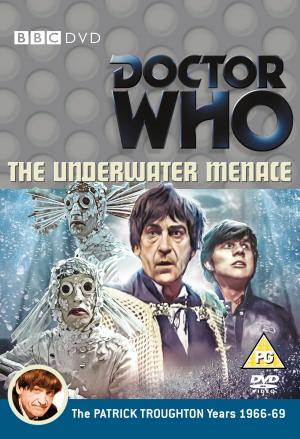

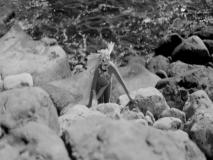
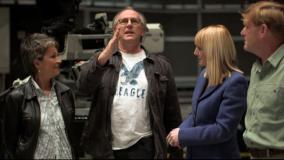
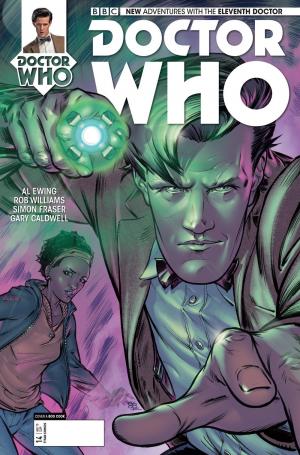 Writers - Al Ewing + Rob Williams
Writers - Al Ewing + Rob Williams

 Circle us on Google+
Circle us on Google+